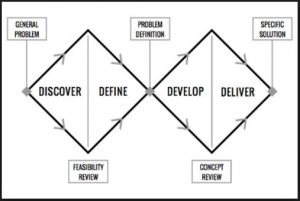Use hacks for innovative curriculum design with students and teachers
By Mel Stopford on November 9, 2016 in Curriculum
“Design Thinking can be a powerful vehicle for deeper learning of content, more divergent thinking and building the thinking skills capacity of learners.” – Ewan Macintosh
New directions require a fresh approach.
Too often we focus on working together to produce a ‘product’, rather than focussing on the impact of our work or the changes that we wish to see. We define and pursue solutions before fully understanding the opportunities in front of us – and that’s where design thinking comes in.
Design thinking facilitates fresh thinking.
Design thinking is an approach similar to that used by product designers. It involves a substantial up-front design process, before the creation of the final solution – and is just as applicable in the education environment.
Working with a local high school in Christchurch which is part of the Grow Waitaha Rebuild Project (www.growwaitaha.co.nz), I was recently involved in a project aimed at meaningfully engaging student voice in curriculum design. School students and leaders partnered to co-create a new curriculum. Twenty-two students (across years 9-13) and eight teachers worked together in real time towards re-imagining the school curriculum. The hui lasted for three hours.
We employed the Double Diamond strategy, a strategy that guides thinking through the phases of Discover, Define, Develop, and Deliver. This strategy is flexible enough to apply to different circumstances – and guides users in defining adaptive plans that respond well to new information.
Working together as equal and valued members of a smaller team, teachers and students talked to one another – really talked. They questioned, they clarified and they explored new ideas. There was a sense that these conversations mattered and just might have a positive impact – a tangible outcome. Engagement was very high throughout the session and the three hours sped by.

The outcomes for the high school
Participants shared a wide variety of ideas. And when we take time to focus on important conversations, great things happen!
Some of the suggestions focussed on the types of learning opportunities students experienced:
Learners need life skills because, surprisingly, they don’t know them!
Students need individualised learning because, surprisingly, school is standardised.
Learners need more field trips because, surprisingly, you learn better through experiences and field trips offer many real life experiences.
Other suggestions focussed on the potential use of spaces (some to be built … others repurposed)
Learners need open spaces because, surprisingly, they open student minds and reduce distractions.
How versatile is the Double Diamond strategy?
Very. The process is easy to follow, and it can fit around the time that you have. At a recent principals’ conference the process was used in 4 x 10 minute sessions. The great thing with this process is once you’ve reached a solution, you can use the process again to explore that solution even further.
Looking for strategies that engage all members of the group in meaningful conversations that matter? I highly recommend the Double Diamond approach.
Get in touch with our team today to learn more about the Double Diamond approach
Other articles you might like
What is their potential to refocus science education?
Local curriculum is causing a buzz around many schools and I hear many leaders and teachers talking about what it means and what they should be doing. I firmly believe that every school has the main elements of their local curriculum alive and kicking within their walls – however, sometimes it is not recognised as such.
“You don’t have to be frightened about learning. You just have to be prepared to ask lots of questions . . . to find out what you don’t know. I like helping the others too . . .” Derek – Year 6 ‘priority learner’
